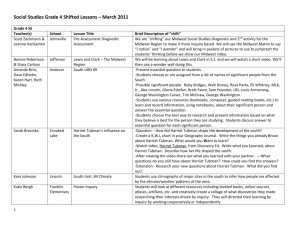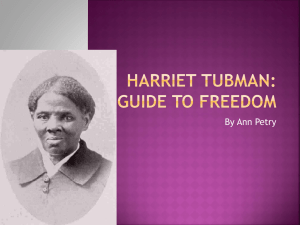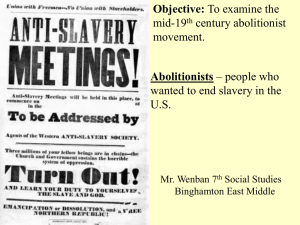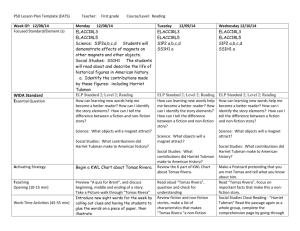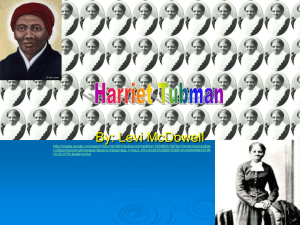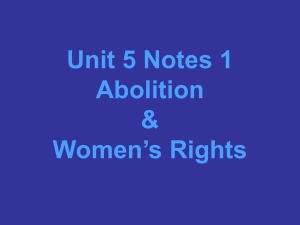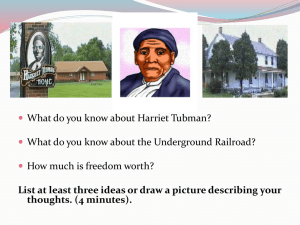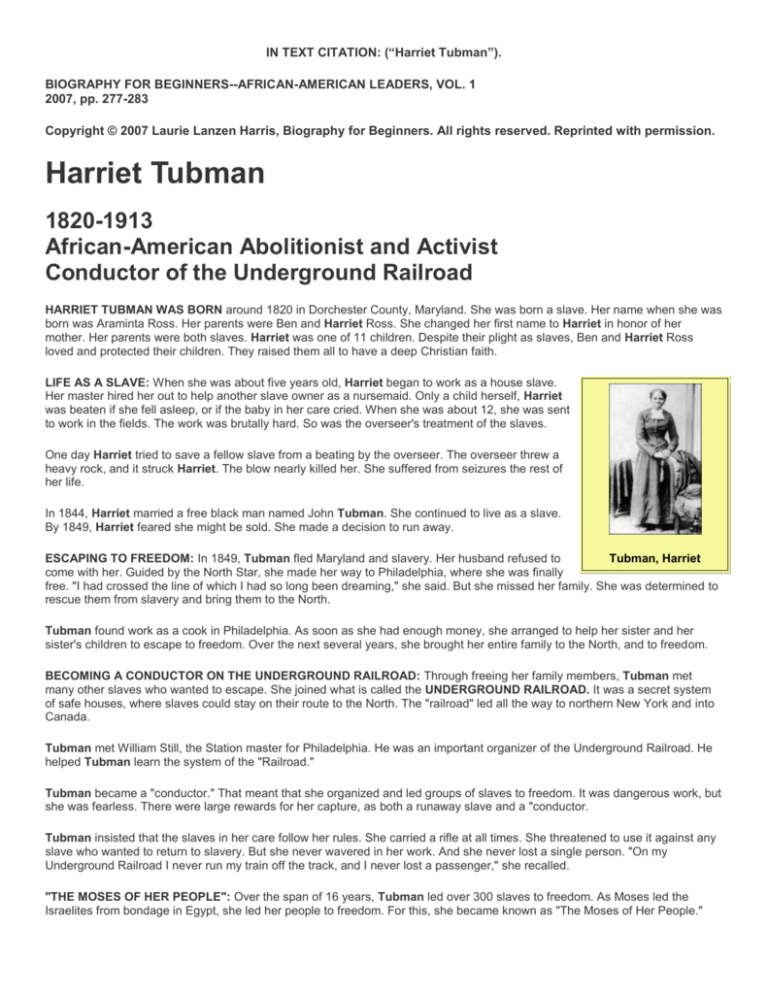
IN TEXT CITATION: (“Harriet Tubman”).
BIOGRAPHY FOR BEGINNERS--AFRICAN-AMERICAN LEADERS, VOL. 1
2007, pp. 277-283
Copyright © 2007 Laurie Lanzen Harris, Biography for Beginners. All rights reserved. Reprinted with permission.
Harriet Tubman
1820-1913
African-American Abolitionist and Activist
Conductor of the Underground Railroad
HARRIET TUBMAN WAS BORN around 1820 in Dorchester County, Maryland. She was born a slave. Her name when she was
born was Araminta Ross. Her parents were Ben and Harriet Ross. She changed her first name to Harriet in honor of her
mother. Her parents were both slaves. Harriet was one of 11 children. Despite their plight as slaves, Ben and Harriet Ross
loved and protected their children. They raised them all to have a deep Christian faith.
LIFE AS A SLAVE: When she was about five years old, Harriet began to work as a house slave.
Her master hired her out to help another slave owner as a nursemaid. Only a child herself, Harriet
was beaten if she fell asleep, or if the baby in her care cried. When she was about 12, she was sent
to work in the fields. The work was brutally hard. So was the overseer's treatment of the slaves.
One day Harriet tried to save a fellow slave from a beating by the overseer. The overseer threw a
heavy rock, and it struck Harriet. The blow nearly killed her. She suffered from seizures the rest of
her life.
In 1844, Harriet married a free black man named John Tubman. She continued to live as a slave.
By 1849, Harriet feared she might be sold. She made a decision to run away.
ESCAPING TO FREEDOM: In 1849, Tubman fled Maryland and slavery. Her husband refused to
Tubman, Harriet
come with her. Guided by the North Star, she made her way to Philadelphia, where she was finally
free. "I had crossed the line of which I had so long been dreaming," she said. But she missed her family. She was determined to
rescue them from slavery and bring them to the North.
Tubman found work as a cook in Philadelphia. As soon as she had enough money, she arranged to help her sister and her
sister's children to escape to freedom. Over the next several years, she brought her entire family to the North, and to freedom.
BECOMING A CONDUCTOR ON THE UNDERGROUND RAILROAD: Through freeing her family members, Tubman met
many other slaves who wanted to escape. She joined what is called the UNDERGROUND RAILROAD. It was a secret system
of safe houses, where slaves could stay on their route to the North. The "railroad" led all the way to northern New York and into
Canada.
Tubman met William Still, the Station master for Philadelphia. He was an important organizer of the Underground Railroad. He
helped Tubman learn the system of the "Railroad."
Tubman became a "conductor." That meant that she organized and led groups of slaves to freedom. It was dangerous work, but
she was fearless. There were large rewards for her capture, as both a runaway slave and a "conductor.
Tubman insisted that the slaves in her care follow her rules. She carried a rifle at all times. She threatened to use it against any
slave who wanted to return to slavery. But she never wavered in her work. And she never lost a single person. "On my
Underground Railroad I never run my train off the track, and I never lost a passenger," she recalled.
"THE MOSES OF HER PEOPLE": Over the span of 16 years, Tubman led over 300 slaves to freedom. As Moses led the
Israelites from bondage in Egypt, she led her people to freedom. For this, she became known as "The Moses of Her People."
Through her work, she met some of the most important ABOLITIONISTS of her time. (Abolitionists wanted to "abolish," or end,
slavery in the country.) She met Frederick Douglass and John Brown. Douglass said, "Excepting John Brown, I know of no one
who has willingly encountered more perils and hardships to serve our enslaved people than Harriet Tubman."
Another important friend was William H. Seward. He was a prominent abolitionist and Republican from Auburn, New York.
Seward championed Tubman, and helped her buy a home in Auburn. He was also Lincoln's Secretary of State as the nation
entered the Civil War.
THE ELECTION OF ABRAHAM LINCOLN: Abraham Lincoln was elected President in 1860. He was the candidate of the
Republican Party. That party had been formed by people who were opposed to slavery in the new territories. The Southern
states knew that a vote for Lincoln was a vote against slavery. Two months after the election, seven Southern states "seceded"
from the Union. That means that they chose to no longer be a part of the United States. Instead, they formed their own new
country, called the Confederate States of America.
THE CIVIL WAR: The national argument over slavery led the nation to Civil War in 1861. The war lasted four years, and losses
on both sides were horrific. Tubman continued to play an important part in her nation's cause. She served as a nurse, a soldier,
and a spy for the Union.
NURSE: In 1862, Tubman was sent to Beaufort, South Carolina, to nurse soldiers. She also helped the new black freedman to
learn to make a living on their own. But her work in South Carolina included other, more dangerous, assignments.
A SPY FOR THE UNION: Tubman led a group of former slaves on a scouting mission. They prepared reports on the location of
Confederate camps for the Union. These aided the invasion of South Carolina led by Colonel James Montgomery. Tubman
served as a soldier for Montgomery, too. In 1863, Tubman and 150 black soldiers took part in a gunboat raid in South Carolina.
SETTLING IN AUBURN, NEW YORK: After the war, Tubman moved to Auburn, New York. She married a soldier she'd met in
the war, Nelson Davis. She decided to devote herself to the care of children and the elderly. She also became involved in the
fight for women's rights.
WOMEN'S RIGHTS ACTIVIST: Tubman met many of the prominent members of the women's rights movement. Susan B.
Anthony and Elizabeth Cady Stanton became her friends and fellow activists. Tubman was a delegate to the National
Federation of Afro-American Women's first meeting in 1896.
BUILDING THE HARRIET TUBMAN HOME: Tubman bought 25 acres of land near her home in Auburn. On that property, she
built the Harriet Tubman Home for Aged and Indigent Colored People. It became home to many of the area's poor and elderly
blacks.
Although she had been a hero of the abolitionist movement and the Civil War, Tubman didn't receive any money for her
services until the 1890s. She died in the home she had created on March 10, 1913, at the age of 93. She was buried in Auburn
with military honors.
HARRIET TUBMAN'S HOME AND FAMILY: Tubman was married twice. Her first husband was John Tubman. He and Harriet
married in 1844. From 1849 until the Civil War, Harriet helped all of her family escape to the North. When she returned for John,
he had married another woman. After the Civil War, Tubman married again. Her second husband was named Nelson Davis.
HER LEGACY: Tubman was a woman of incredible courage and devotion to the cause of freedom. Yet this champion of civil
rights rarely received the honors she surely deserved. "I have wrought in the day-you in the night," wrote Frederick Douglass to
Tubman. "I have had the applause of the crowd and the satisfaction that comes of being approved by the multitude. The most
that you have done has been witnessed by a few trembling, scarred, and footsore bondsmen and women, whose heartfelt "God
bless you' has been your only reward."
In recent years, Tubman's achievements have been more widely recognized. Her Auburn home is now a state historical site. In
1995, the U.S. Post Office honored her with a commemorative stamp. And in 2003, the Governor of New York declared March
10th "Harriet Tubman Day."
MLA SOURCE CITATION: "Harriet Tubman." Biography for Beginners--African-American Leaders, Vol. 1. 2007: 277283. SIRS Discoverer. Web. 10 Oct 2013.


